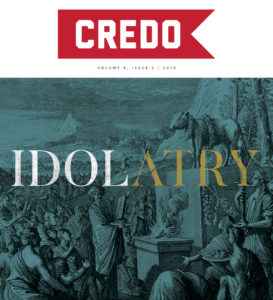The book of Revelation, much debated and often neglected, provides an important voice on the issue of idolatry in the New Testament. One of the issues in the history of the interpretation of Revelation is the question of whether Revelation should be seen as referring primarily to events in the context of the first century (and/or near future), as a timeless/symbolic depiction, or as referring to events in the future. There is a growing recognition on the part of interpreters that these approaches can be combined in a meaningful way. This article will proceed along similar lines. For the sake of discussion, we will look to the messages to the seven churches, idolatry in the context of judgment, the worship of the beast and its image, true devotion to God, and the concluding vision of the New Heavens and New Earth.
Messages to the Seven Churches
One of the initial references to idolatry arises in the discussion of false teaching in the messages to the seven churches in Revelation 2-3. The messages to the churches at Pergamum and Thyatira challenge those who “hold to the teachings of Balaam” and the woman “Jezebel.” While it is unclear that these are to be identified as the same group, the same charges of teaching the people of God “to commit sexual immorality” and “to eat food sacrificed to idols” are leveled. The particular term for the latter appears in discussions in Acts 15 and 1 Corinthians 8-10.
In the context of Revelation 2-3, the false teacher(s) challenged by John appear to be advocating greater accommodation to the culture. The pull toward this kind of accommodation can be seen in light of the social and economic challenges facing Christ-followers in this context. Those advocating an allowance of this practice may have sought to ease these pressures through allowing greater participation in the religious practices of the surrounding culture, perhaps even identifying certain practices as non-religious in nature (such as appears to be the case in 1 Cor. 8). This kind of activity, however, is condemned as a compromise of one’s faithfulness to Christ.
Idolatry and Judgment
Through the rest of the book, worship of other entities may be observed. The sequences of the seals, trumpets, and bowls (and the intervening interludes) occupy much of the narrative between chapters 6 and 16. The issue of idolatry comes chiefly to the forefront in Revelation 9 in response to the outcome of the sounding of the sixth trumpet. For the remaining two-thirds of humanity not killed by the plagues, they “did not repent of the works of their hands, so as to not worship demons and idols of gold and silver and bronze and stone and wood, which are not able to see nor hear nor walk.” (9:20).
The phrasing employed by John reflects polemics against idolatry in other Jewish writings. Deuteronomy 32:17 makes a similar connection between idolatry and the worship of demons. The polemic against idols as objects merely fashioned from various materials and unable to see, hear, or walk echoes the language used in Isaiah 44:9-20 to depict the folly of idolatry (see also Pss. 96:5; 115:4-8). Jewish writings of the second temple period likewise reflect a similar conviction (see Wisdom of Solomon 15:15-17; 1 Enoch 99:6-7).
The context of this assessment is significant, as it comes in a series of statements beginning in Revelation 6 concerning the refusal to repent in light of the unfolding judgments within the book. Revelation 6:16-17 notes the identification of the source of these judgments as being the “one seated on the throne and… the Lamb,” and Revelation 16 repeats the refrain twice (16:9, 11) concerning the refusal to repent. Through these descriptions, John demonstrates that divine judgment does not remove the problem of idolatry.
The Worship of the Beast
One of the central conflicts in the narrative is between the Lamb and the Beast. As the narrative unfolds, particularly from Revelation 13 onward, clear contrasts can be observed between the depictions of crowns worn by each (Rev. 12:3; 13:1; 19:12), the mortal wound/recovery of the beast (13:3, 12) and the death/resurrection of Jesus (1:5, 8; 2:8; 5:6, 9, 12; 7:14; 12:11; 13:8), the sealing/marking of the respective followers (7:1-8; 13:6-7), the rule over every “tribe, tongue, people, and nation” (5:9; 14:6; 10:11; 13:7; 11:19; 17:15), and the authority to rule (13:12; 2:26-28) and command great armies (16:14; 19:19; 19:14). The issue of worship likewise plays a central role. Within Revelation 13, worship is directed toward the beast and the dragon in response to their power and authority.
The third figure, the beast from the land, serves an important role in advancing the worship of the beast through the creation and animation of a cultic image (Rev 13:13-15). The creation of this image reflects practices in the first century associated with the worship of the Roman Emperor. The practice of directing cultic honors toward the emperor was an important feature of the religious landscape in the late first century AD. Beyond engagement with this element in John’s day, the depiction in Rev 13 alludes to Daniel 3 and the image of Nebuchadnezzar. The worship of the beast from the sea and its image is advanced through the military power (13:15; cf. 13:7-10) and economic authority (13:16-18) of the beast from the land.
Although the imagery is cast in the first-century context, the figure of the beast from the sea appears to transcend identification simply with the reigning emperor. In light of wider anticipation of an eschatological opponent (i.e. 2 Thess. 2), it seems best to identify the beast as modeled after the authority of the emperor, understood through the lens of Daniel 7, and as anticipating a final political and religious authority in opposition to the people of God.
The Worship of the Lamb
The condemnation of the worship of the beast and its image as ultimately associated with the dragon/Devil provides only one aspect of John’s response. Although this worship appears to be widespread among the earth-dwellers, John provides his readers with the heavenly perspective that not only unmasks the nature of evil but also provides a compelling picture of the reality of heavenly worship. The vision of the heavenly throne room in Revelation 4-5 draws heavily upon imagery in Isaiah 6, Ezekiel 1, and Daniel 7. In doing so, the reader is able to identify the scene with these significant visions in the Old Testament. It is in this context that the Lamb is introduced and given worship alongside the One seated on the throne (5:12-13; cf. 4:11; see also 7:9-10). For those facing the hostility of an idolatrous culture as a result of exclusive devotion to Christ, these visions provide encouragement to remain faithful despite what appears to be the case on earth. For those facing the hostility of an idolatrous culture as a result of exclusive devotion to Christ, these visions provide encouragement to remain faithful despite what appears to be the case on earth. Click To Tweet
The Final Vision
The final vision contains the last direct references to idolatry in the book of Revelation. The two passages, Revelation 21:8 and 22:15, provide descriptions of those excluded from sonship and from access to the tree of life, respectively. The lists are not identical, but there are several terms in common between the two. Two of the elements, “the sexually immoral” and “idolaters,” draw a connection back to the condemnation of the false teachers in Revelation 2. With the later term in Revelation 21:8 and 22:15, the focus is upon those who commit idolatry rather than the consumption of food. The references to “lying”/“falsehood” challenge the false apostles/teaching condemned in chapters 2-3 as well as the false prophet/beast from the land. These statements in Revelation 21 and 22 serve as final warnings against these practices as inappropriate for the people of God.
Concluding Reflections
As John addresses these various issues dealing with idolatry, he engages the problem in a way that speaks to the context of his day as well as future generations. Within the book as a whole, several conclusions may be drawn:
First, John calls followers of the Lamb to think critically about the nature of cultural accommodation and idolatry. Although the language in Revelation is cast in the context of pagan religion and images created to represent various gods, the call to abstain from practices accommodating the culture in a way that betrays one’s exclusive devotion to Christ remains relevant today.
Second, John demonstrates that divine judgment does not solve the problem of idolatry. The issues of repentance and conversion are worthy of attention in the book, and John’s emphasis upon “witness” provides an important insight into the conversion of the “tribes, tongues, peoples, and nations” in the book.
Finally, John’s discussion in Revelation encourages followers of Christ toward faithful devotion to the Lamb and the One seated on the throne. In a world filled with various religions and forms of worship, John demonstrates the reality of the worship taking place in the heavenly throne room. All forms of idolatry fall woefully short of this reality, and this heavenly practice will find a full and final expression in the new heavens and new earth.


